The Amazing Horseshoe Crab
Species > Horseshoe Crab
 |
| Source: National Parks Service - Smaller male mating with large female |
This fascinating, prehistoric looking creature is usually shunned by most who think they are dangerous. No they do not sting or bite! Most of us have no idea how amazing they are. Every day the horseshoe crab saves lives!
Horseshoe crabs are found all over Florida and are not seen often because they are nocturnal feeders. You will find their molted carcasses scattered on the beaches year round, evidence they are out there lurking in our shallow bays and beaches.
The horseshoe crab has been helping out humans, birds, and the oceans everyday for over 400 million years!
So what's their secret to survival? They are nocturnal, coming out mostly at night to avoid predators. They also have the ability to re-grow lost limbs like lobsters and star fish, ensuring their survival. And they have no food value to humans, so they have been left alone. Plus they look scary so humans stay clear of them.
So what are they good for?
Horseshoe Crabs Help Everyone
Humans Benefits
The horseshoe crab had benefited mankind in many ways:
Tools and Food
 For millions of years, and even today around the world, the hard helmet-shaped shell has been used by humans to scoop water from canoes, to shovel soft sand, as food bowls, and as storage containers.
For millions of years, and even today around the world, the hard helmet-shaped shell has been used by humans to scoop water from canoes, to shovel soft sand, as food bowls, and as storage containers.
The muscle meat located at the base of the tail was eaten; the rest the body meat was used as bait and chum for traps.
The tail, called the telson, is lined with spikes and made great spear tips used for self defense. No part of the horseshoe was wasted.
| Source: http://www.dnrec.delaware.gov Historical Photo of Commercial Harvesting in Delaware |
Commercial Uses
In the late 1800's to early 1900's, millions of horseshoes were harvested annually before the advent of synthetic fertilizers. Horseshoe crabs were commercially harvested, dried, ground, then used for fertilizer. The dried crab was also used as a supplement in livestock feed for chickens and hogs, but soon it was discovered the additive made the chicken and hog meat taste bad so the horseshoe crab supplement was discontinued. Good thing for the horseshoe, look at this historical Delaware photo of the harvesting and the millions of shells stacked at a shipyard, not a pretty sight.
Today, horseshoes are harvested commercially and sold as bait to the conch and American eel fisheries. The demand for horseshoes for bait has been reduced 50% to 75% in recent years due to an innovative trap baiting technique of using a mesh bag to hold pieces of the horseshoe instead of the whole carcasses.
Amazing Blue Blood
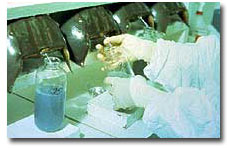 |
| Photo by BioWhittaker, Inc. Bleeding Horseshoes |
Humans start their lives getting injections and most of us have had surgery. Guess what? A horseshoe crab has helped you during these medical procedures. The blood of the Horseshoe contains copper which makes the blood a light blue color. This amazing blue blood contains a special clotting agent called LAL (Limulus Amoebocyte Lysate) which is used to test the purity of medicines. LAL clots when exposed to endotoxins, which are chemical poisons released by infectious bacteria.
The FDA requires LAL testing on all human and animal injectable and intravenous drugs, on medical devices used to deliver injectable drugs, and on all prosthetic devices (ex. hip and knee replacements, heart valves). Pharmaceutical companies use LAL to test the sterility of antibiotics and kidney dialyzers, to detect some cancers and spinal meningitis.
The horseshoes own survival is credited to the amazing properties of their blue blood. Blood-clotting granules are released when the horseshoe gets wounded; the blood actually acts a seal to prevent infection and promote rapid healing.
Multiple Uses of the Shell
| Image Mary Hollinger, NODC biologist, NOAA This carapace was empty. Picking up a live horseshoe by the tail can injure them. |
The exoskeletons outer shell contain a cellulose-like substance Chitin that is used to produce many products that help humans:
- Chitin-coated sutures are produced for wound dressing of burn victims skin. The properties chitin promote rapid wound healing, reducing healing time from 35% to 50% - amazing!
- Chitin promotes healing of ulcers and lesions, serves as an antibacterial action, acts as an antacid, helps control high blood pressure, and is used to treat and prevent irritable bowel syndrome.
- Chitin is used in weight loss products because it has the ability to mind with fats that are then passed through the body without being absorbed.
- Chitin is used in cholesterol drugs for it's ability to inhibit bad cholesterol and boost good cholesterol.
- Chitin is made into a string used to suture surgical wounds and in wound dressings which dissolve quickly and promote healing.
- When chitin is processed, chitosan is produced which can be used as a raw material to make contact lenses, skin creams, and hair sprays.
- Chitin is used to remove lead and other harmful chemicals from wastewater.
Interestingly, other arthropods including lobsters, crabs, shrimp, spiders, beetles, and mosquitoes, also contain chitin in their exoskeletons.
Human Eye Research
The eyes of the horseshoe are easy to study and have been used for over 50 years in research of human eyes. Important principals have been discovered after studying horseshoe's eyes and optic nerves.
Creating Jobs
Harvesting horseshoe crab blood can be a lucrative occupation for those who dare to perform this nasty deed. Horseshoe crabs survive just fine after removing 30% of their blood, which is painless - another amazing feat of the horseshoe! Currently their blood fetches a cool $15,000 a quart and it's a multi-million dollar industry. There is a special license you can purchase to harvest horseshoe crab blood, see the Full Florida Law below for information on this. Currently there are no blood harvester licenses issued in Florida - guess nobody wants to tackle the job. Watch this video on the process of "borrowing" horseshoe crabs and learn more about their amazing blood.
Shore Bird Survival
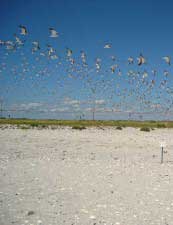 The horseshoe crab's spawning on beaches coincides with the spring spawning of shore birds and is a critical element in many birds survival. The female horseshoe lays its eggs on the beaches which in turn provide nutritious meals for the nesting birds. Numerous bird species rely on these eggs for their survival - each bird can double its weight in less than two weeks by eating thousands of horseshoe crab eggs.
The horseshoe crab's spawning on beaches coincides with the spring spawning of shore birds and is a critical element in many birds survival. The female horseshoe lays its eggs on the beaches which in turn provide nutritious meals for the nesting birds. Numerous bird species rely on these eggs for their survival - each bird can double its weight in less than two weeks by eating thousands of horseshoe crab eggs.
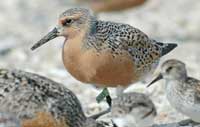 |
| Courtesy NWS The Red Knot relies on the horseshoe for its survival. |
So you may wonder how the horseshoe populations survive when their eggs are freely dined on? Well, each female Horseshoe lays 4,000 blue green colored buckshot-sized eggs in each nest, laying eggs 6 times a year which produces a whopping 100,000 total eggs a year! It takes the eggs 2 to 4 weeks to mature, then the hatched larvae, which do not have tails yet, wait for a high tide to wash them out to sea and surprisingly most survive.
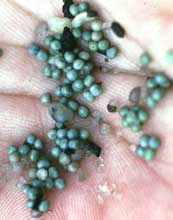 |
| Courtesy NWS - Horseshoe Eggs |
Large spawnings generally occur mid to late May in coastal mid-Atlantic states during full or new moon tides, in the evening at high tide.
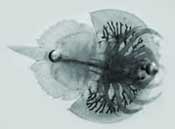 |
Courtesy of the Wetlands Institute |
One female can be found surrounded by as many as 12 males during their spawning sessions. Since the eggs are far above the high tide mark, they are protected from being washed out by tides and allowed to mature.
During spring and fall migrations, shore birds rely on the horseshoe crabs eggs as their main meal during long migrations to and from the north. Many birds travel non-stop some 5,000 miles during these trips. Delaware Bay hosts the second largest concentration of migrating birds in North America due to the fact that they have the largest concentration of horseshoe crabs in the world.
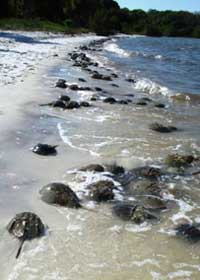 |
| Photo Courtesy of FWC |
Keeping the Oceans Healthy
The horseshoe crab spends most of its time foraging around for food on the the sandy sea floor. Their plow-like sifting and scraping of the ocean floor stirs up sediment and aerates it, keeping the ocean floors healthy.
Fish, crabs, sea turtles, sharks and other marine species feed on live horseshoe crabs, vulnerable juveniles, their eggs and larvae, and the shells left behind after molting. The Horseshoe is fully mature at 10 years old and will molt 16 times during this period - that's a lot of shells left behind to feed the masses.
Few Benefits for Anglers
Horseshoe crabs make great bait for eels and conch, that's about it! They have no food value so they are generally ignored. They can be a nuisance to seine netters in areas where they are prevalent like the Tampa Bay area or in the Delaware Bay.
FWC asks beachgoers to
report horseshoe sightings
and matings
horseshoe@MyFWC.com
Call 866-252-9326
Online Sighting Form
The Horseshoe Crab
 |
| Courtesy of FWS |
Horseshoe crabs are invertebrates with jointed legs but they are not related to crabs, their closest living relatives are spiders and scorpions. They are called a "living fossil" because they have not changed much in millions of years. With 4 eyes and 7 pairs of legs they are not like a crab at all.
There are 4 species of Horseshoe Crab around the world. American has only one of these species, the American horseshoe crab. The horseshoe can be found from Maine all the way around Florida and throughout the Gulf of Mexico living in shallow coastal waters with sandy or muddy bottoms feeding mostly on molluscs and worms but sometimes small fish and crustaceans.
 |
| Source: National Parks Service - Smaller male mating with large female |
Females are bigger than males and at maturity can grow their shells from 9 to 12 inches across and with the sword they can be 20 inches long! All horseshoes have 7 pairs of legs, 5 pairs have little claws and are used for walking and rooting around for food. The other 2 sets of legs are used for feeding and mating. The adult male's second pair of claws have a boxing-glove appearance designed to grasp females during spawning.
As the horseshoe grows, it sheds its hard shell, a process called molting, 6 times their first year of life and a total of about 18 times before they reach sexual maturity. A new soft shell grows underneath their existing hard shell and when molting is completed, the soft shell will harden in a day or two. After molding, the Horseshoe Crab emerges with a shell 25% larger than before. The horseshoe reaches maturity at around 10 years old and the female will actually molt many times more than the male, hence the reason the female is much larger than the male. Once they reach their sexual maturity, the horseshoe crab ceases molting and will retain its last shell for the rest of its life - their lifespan is about 20 years.
The long sword-like tail projecting from the Horseshoe's behind is not poisonous as most think - it is actually used as a rudder and push pole. Horseshoes swim at an angle and sometimes upside down, so the sword comes in handy as a rudder while swimming or rooting around the bottom. When a wave crashes over the Horseshoe at the shore over turning him, they use the long sword to right themselves.
You can get stabbed by the horseshoe though, they have very sharp projections along their helmet-shaped shell which protects their delicate undersides from predators. If you try to pick one up, do so gently, then hold it upside down like you would a soup bowl to avoid the sharp spikes.
Another amazing feature of the horseshoe are their 10 eyes on top of their carapace allowing them to see during the day and at night.
Florida Harvesting Laws
Summary
Since horseshoe crab are not good to eat and only used as bait for eels, they are not harvested very often by recreational anglers. But if you must, here are the Florida rules:
- A Saltwater license is required to harvest horseshoe crabs
- Allowed Gear: Hand collecting or by gig
- Harvest Limits:
- Recreational - 25 per person per day
- Commercial - 100 per person per day
![]() The horseshoe crab has experienced declining numbers in recent years, drawing attention to conservationists to protect this incredibly important species, so the harvest of this species could be prohibited in the future. We encourage beach visitors to respect and protect horseshoe crabs. If you see one stuck on it's back, please gently turn it over and point it towards the sea. If they are mating or molting give them a wide berth. Horseshoe crabs can bake in the sun and die, so if one appears to be stranded on the beach, please help it find it's way to the waters edge.
The horseshoe crab has experienced declining numbers in recent years, drawing attention to conservationists to protect this incredibly important species, so the harvest of this species could be prohibited in the future. We encourage beach visitors to respect and protect horseshoe crabs. If you see one stuck on it's back, please gently turn it over and point it towards the sea. If they are mating or molting give them a wide berth. Horseshoe crabs can bake in the sun and die, so if one appears to be stranded on the beach, please help it find it's way to the waters edge.
Full Florida Law
CHAPTER 68B-46
HORSESHOE CRABS
68B-46.001 ????? Definitions
68B-46.002 ????? Horseshoe Crabs Harvest Restrictions: License Requirements, Gear Specifications, Daily Bag and Possession Limits
68B-46.001 Definitions.
As used in this rule chapter:
(1) “Harvest” means the catching or taking of a horseshoe crab, by any means whatsoever, followed by a reduction of such crab to possession. Horseshoe crabs that are caught but immediately returned to the water free, alive, and unharmed are not harvested.
(2) “Horseshoe crab” means any arthropod of the species Limulus polyphemus, or any part thereof.
Specific Authority Art. IV, Sec. 9, Fla. Const. Law Implemented Art. IV, Sec. 9, Fla. Const. History?New 3-30-00.
68B-46.002 Horseshoe Crabs Harvest Restrictions: License Requirements, Gear Specifications, Daily Bag and Possession Limits.
(1) No person shall harvest, possess, or sell any horseshoe crab unless that person possesses a valid saltwater products license. Horseshoe crabs shall be considered saltwater products for purposes of Section 379.362, F.S.
(2) The harvest or attempted harvest of any horseshoe crab by or with the use of any means or gear other than by hand or gig is prohibited.
(3)(a) Except as provided in paragraph (b), no person shall harvest in any day, within or without the waters of the state, land, or possess while in or on the waters of the state more than 25 horseshoe crabs. No such person shall possess more than 25 horseshoe crabs while in, on, or above the waters of the state or on any dock, pier, bridge, beach, or other fishing site adjacent to such waters.
(b)1. The following bag and possession limits apply to a person with a valid saltwater products license with a marine life endorsement:
a. No such person shall harvest in any one day, within or without the waters of the state, land, or possess while in or on the waters of the state more than 100 horseshoe crabs.
b. No such person shall possess more than 100 horseshoe crabs while in, on, or above the waters of the state or on any dock, pier, bridge, beach, or other fishing site adjacent to such waters.
2. The following bag and possession limits apply to a person with a valid saltwater products license and a valid permit to harvest eels commercially in the freshwaters of the state:
a. No such person shall harvest in any one day, within or without the waters of the state, land, or possess while in or on the saltwaters of the state more than 100 horseshoe crabs.
b. No such person shall possess more than 100 horseshoe crabs while in, on, or above the saltwaters of the state or on any dock, pier, bridge, beach, or other fishing site adjacent to such waters.
3. The following provisions apply to each person collecting horseshoe crabs for biomedical purposes:
a. No person shall collect horseshoe crabs for biomedical purposes without possessing a valid Horseshoe Crab Biomedical Collecting Permit. This is not a harvesting permit, but rather allows the holder to temporarily possess horseshoe crabs for the purpose of collecting the blood of the animal.
b. Horseshoe crabs collected for biomedical purposes shall be handled so as to minimize injury, maintained alive, and released alive in the area where collected.
c. Persons possessing a valid Horseshoe Crab Biomedical Collecting Permit are exempted from bag and possession limits specified in paragraph (a) of this subsection if the horseshoe crabs collected are maintained and released alive.
d. The Horseshoe Crab Biomedical Collection Permit shall be renewed each year if the holder files the report required in sub-subparagraph e.
e. Each person holding a Horseshoe Crab Biomedical Collection Permit shall file with the Division of Marine Fisheries by May 1 each year a report detailing the use of horseshoe crabs. Such reports will be filed on forms provided by the Division (Form DMF-HSC001 (7-02)) and will include a monthly account of the number of crabs collected, areas where horseshoe crabs were collected, statement of percent mortality up to the point of release, and a certification that collected horseshoe crabs are solely used by the biomedical facility for biomedical purposes and not for other purposes.
Specific Authority Art. IV, Sec. 9, Fla. Const. Law Implemented Art. IV, Sec. 9, Fla. Const. History?New 3-30-00, Amended 7-9-02.
Law current as of October 8, 2012











